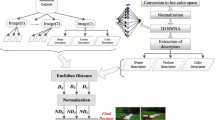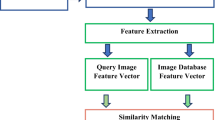Abstract
We propose an interactive content based image retrieval (CBIR) system using M-band wavelet features with earth mover’s distance (EMD). A fuzzy relevance feedback (FRF) method is proposed to enhance the retrieval mechanism in order to retrieve more images which are semantically close to the query. M × M sub-bands coefficient are used as primitive features, on which, for each pixel, energies are computed over a neighborhood and are taken as features for each pixel to characterize its color and texture properties. Based on the energy property, pixels are clustered using fuzzy C-means algorithm to obtain an image signature. The EMD is used as a distance measure between the signatures for different images of the database. Combining information both from relevant and irrelevant images marked by the user, fuzzy entropy based feature evaluation mechanism is used for automatic computation of revised feature importance and similarity distance at the end of each iteration. The proposed CBIR system performance using M-band wavelets feature are compared to that of Moving Picture Expert Group-7 visual features which have almost become a standard benchmark for both video and image representation and comparison. The proposed FRF technique using EMD is compared with different other similarity measures to test the effectiveness of the system on standard image database.










Similar content being viewed by others
Explore related subjects
Discover the latest articles, news and stories from top researchers in related subjects.References
Chen Y, Wang JZ, Krovet R (2005) Cluster based retrieval of images by unsupervised learning. IEEE Trans Image Process 14:1187–1201
Kekre HB, Thepade SD, Maloo A (2010) Image retrieval using fractional coefficients of transformed image using DCT and Walsh transform. Int J Eng Sci Technol 2:362–371
Heesch D (2008) A survey of browsing models for content based image retrieval. Multimed Tools Appl 40:1380–7501
Smeulders AWM, Worring M, Santini S, Gupta A, Jain R (2000) Content based image retrieval at the end of early years. IEEE Trans Pattern Anal Mach Intell 22:1349–1380
Xiaoling W, Hongyan M (2009) Enhancing color histogram for image retrieval. In: Proceedings of the international workshop on information security and application. Academy Publisher, New York
Ksantini R, Ziou D, Dubeau F (2006) Image retrieval based on region separation and multiresolution analysis. Int J Wavelets Multiresolution Inf Process 4:147–175
Banerjee M, Kundu MK, Maji P (2009) Content based image retrieval using visually significant point features. Fuzzy Sets Syst 160:3323–3341
Santini S, Jain R (1999) Similarity measures. IEEE Trans Pattern Anal Mach Intell 21:871–883
Rubner Y, Tomasi C (2001) Perceptual metrics for image database navigation. Kluwer, Dordrecht
Rubner Y, Tomasi C, Guibas LJ (2000) The earth mover’s distance as a metric for image retrieval. Int J Comput Vis 40:99–121
Yin P-Y, Bhanu B, Chang K-C, Dong A (2005) Integrating relevance feedback techniques for image retrieval using reinforcement learning. IEEE Trans Pattern Anal Mach Intell 27:1536–1551
Han J, Ngan KN, Li M, Zhang HJ (2005) A memory learning framework for effective image retrieval. IEEE Trans Image Process 14:521–524
Chang FC, Hang HM (2006) A relevance feedback image retrieval scheme using multi-instance and pseudo image concepts. IEICE Trans Inf Syst 89-D(5):1720–1731
Kim W-C, Song J-Y, Kim S-W, Park S (2008) Image retrieval model based on weighted visual features determined by relevance feedback. Inf Sci 178:4301–4313
Rui Y, Huang TS, Ortega M, Mehrotra S (1997) Content-based image retrieval with relevance feedback in mars. Proc IEEE Int Conf Image Process 2:815–818
Jin Z, King I, Li XQ (2000) Content-based image retrieval by relevance feedback. In: Advances in visual information systems. Lecturer notes in computer science, vol 1929. Springer, Berlin, pp 639–648
Marakakis A, Galatsanos N, Likas A, Stafylopatis A (2009) Probabilistic relevance feedback approach for content-based image retrieval based on Gaussian mixture models. IET Image Process 3:10–15
Ves ED, Domingo J, Ayala G, Zuccarello P (2006) A novel Bayesian framework for relevance feedback in image content-based retrieval systems. Pattern Recognit 39:1622–1632
Shi Z, He Q, Shi Z (2007) Bayes-based relevance feedback method for CBIR. Adv Soft Comput 44:264–271
Qian F, Zhang B, Lin F (2003) Constructive learning algorithm-based RBF network for relevance feedback in image retrieval. In: Proceedings of the 2nd international conference on Image and video retrieval. Lecturer notes in computer science, vol 2728. Springer, Berlin, pp 352–361
He X, King O, Ma W, Li M, Zhang HJ (2003) Learning a semantic space from user’s relevance feedback for image retrieval. IEEE Trans Circuits Syst Video Technol 13:39–48
Acharyya M, Kundu MK (2008) Extraction of noise tolerant, gray-scale transform and rotation invariant features for texture segmentation using wavelet frames. Int J Wavelets Multiresolution Inf Process 6:391–417
Manjunath BS, Ohm JR, Vasudevan VV (2001) Color and texture descriptors. IEEE Trans Circuits Syst Video Technol 11:703–715
Wu P, Manjunath BS, Newsam S, Shin HD (2000) A texture descriptor for browsing and similarity retrieval. Signal Process Image Commun 16:33–43
Manjunath BS, Salembier P, Sikora T (2002) Introduction to MPEG-7: multimedia content description interface. Wiley, New York
Wang JZ, Li J, Wiederhold G (2001) SIMPLIcity: semantics-sensitive integrated matching for picture libraries. IEEE Trans Pattern Anal Mach Intell 23:947–963
Acharyya M, Kundu MK (2001) An adaptive approach to unsupervised texture segmentation using M-band wavelet transform. Signal Process 81:1337–1356
Burrus CS, Gopinath A, Guo H (1998) Introduction to wavelets and wavelet transform: a primer. Prentice Hall International Editions, Englewood Cliffs
Kundu MK, Banerjee M, Bagrecha P (2009) An interactive image retrieval in a fuzzy framework. In: Proceedings 8th international workshop on fuzzy logic and application. Lecturer notes in artificial intelligence, vol 5571. Springer, Berlin, pp 246–253
Kundu MK, Acharyya M (2003) M-band wavelet: application to texture segmentation for real life image analysis. Int J Wavelets Multiresolution Inf Process 1:115–149
Acharyya M, De RK, Kundu MK (2003) Extraction of features using M-band wavelet packet frames and their neuro-fuzzy evaluation for multi-texture segmentation. IEEE Trans Pattern Anal Mach Intell 25:1639–1644
Pal SK, Majumder DD (1985) Fuzzy mathematical approach to pattern recognition. Wiley Eastern Limited, New York
Liang J, Song W (2011) Clustering based on Steiner points. Int J Mach Learn Cybern. doi:10.1007/s13042-011-0047-7
Graaff AJ, Engelbrecht AP (2011) Clustering data in stationary environments with a local network neighborhood artificial immune system. Int J Mach Learn Cybern. doi:10.1007/s13042-011-0041-0
Guo G, Chen S, Chen L (2011) Soft subspace clustering with an improved feature weight self-adjustment mechanism. Int J Mach Learn Cybern. doi:10.1007/s13042-011-0038-8
Wang XZ, Zhai JH, Lu SX (2008) Induction of multiple fuzzy decision trees based on rough set technique. Inf Sci 178:3188–3202
Wang XZ, Dong CR (2009) Improving generalization of fuzzy if-then rules by maximizing fuzzy entropy. IEEE Trans Fuzzy Syst 17:556–567
Jun W, Shitong W, Chung FL (2011) Positive and negative fuzzy rule system, extreme learning machine and image classification. Int J Mach Learn Cybern. doi:10.1007/s13042-011-0024-1
Liu H, Song D, Rüger S, Hu R, Uren V (2008) Comparing dissimilarity measures for content-based image retrieval. In: The 4th Asia information retrieval symposium (AIRS2008). Springer, Berlin, pp 44-50
Author information
Authors and Affiliations
Corresponding author
Rights and permissions
About this article
Cite this article
Kundu, M.K., Chowdhury, M. & Banerjee, M. Interactive image retrieval using M-band wavelet, earth mover’s distance and fuzzy relevance feedback. Int. J. Mach. Learn. & Cyber. 3, 285–296 (2012). https://doi.org/10.1007/s13042-011-0062-8
Received:
Accepted:
Published:
Issue Date:
DOI: https://doi.org/10.1007/s13042-011-0062-8




